Welcome to the John Crane Lifecycle Cost Calculator
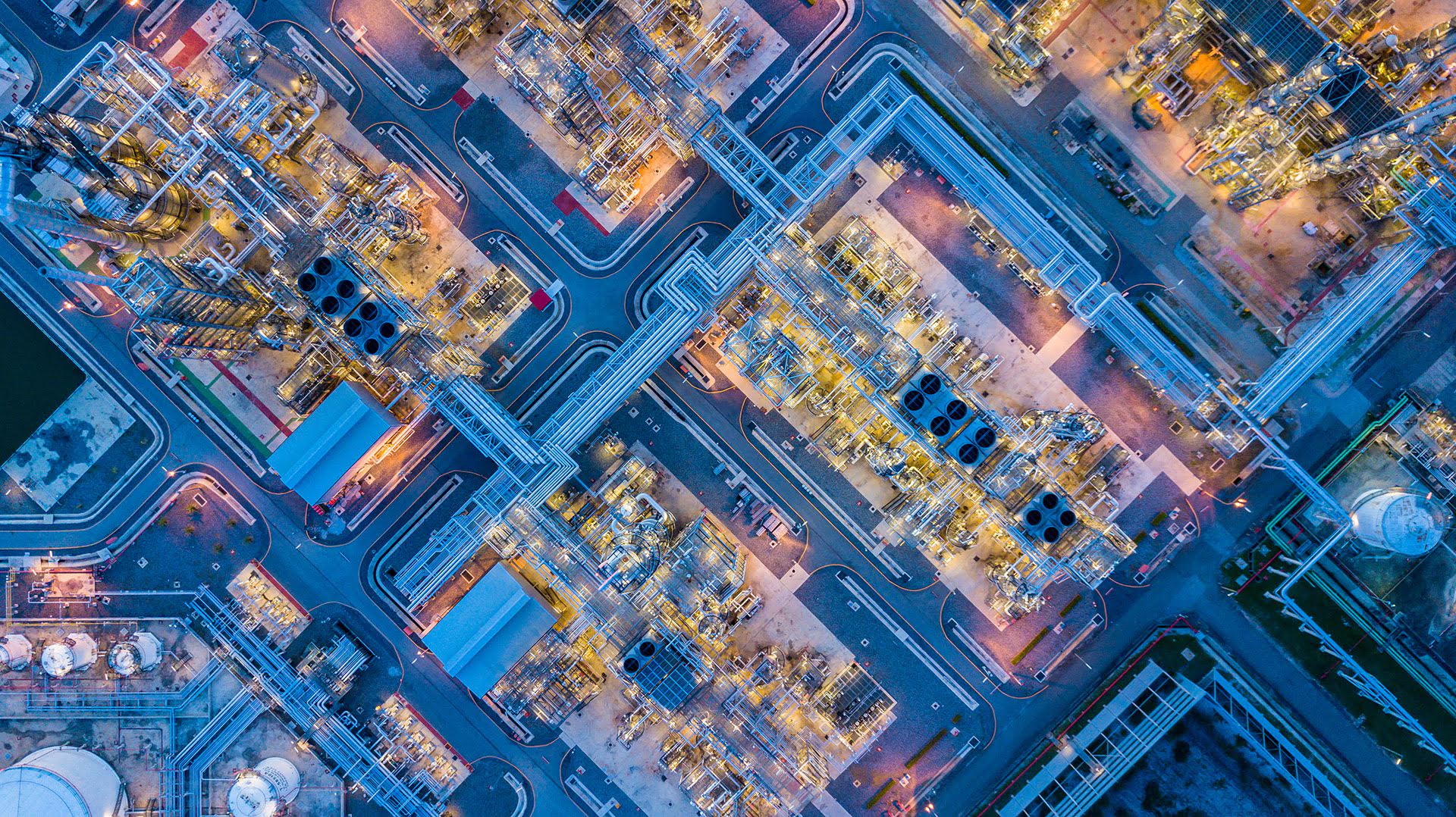
Populating the input information
The gas compressor seal lifecycle cost estimator gathers a wide range of input data for the existing compressor and shaft seal and each of the shaft sealing technologies. The input data is grouped into common attributes listed in the “Inputs” menu.
Each Input parameter is initially populated by a default value that represents a typical value that can be used in the event that specific information is not available at the time of data entry. Some or all of these default values can be changed to customize the results for your scenario. The results will of course be influenced by the values of the variables used during the calculations. You are encouraged to research the existing operating parameters and utility requirements of the existing sealing system you are using. John Crane can provide guidance with estimating parameters when evaluating upgrading from an oil seal system to a dry gas seal system.
After completing the input of data at each input section, click the “Next” button to save the changes made before moving onto the Input section.
Scenarios
Scenario 1
Traditional oil seal and the associated seal support system with seal leakage vented to atmosphere.
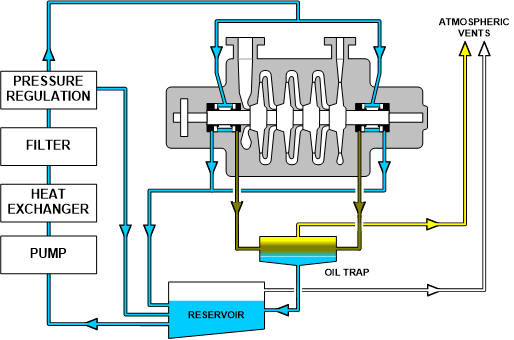
Scenario 2
Traditional oil seal and the associated seal support system with seal leakage vented to flare.
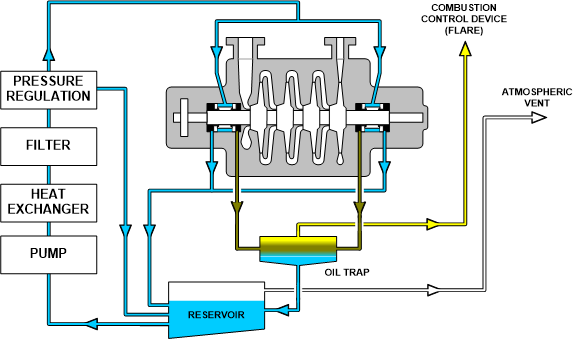
Scenario 3
Traditional oil seal and support system fitted with an enhanced leakage recovery system which captures seal leakage and redirects it to an alternative value adding use.
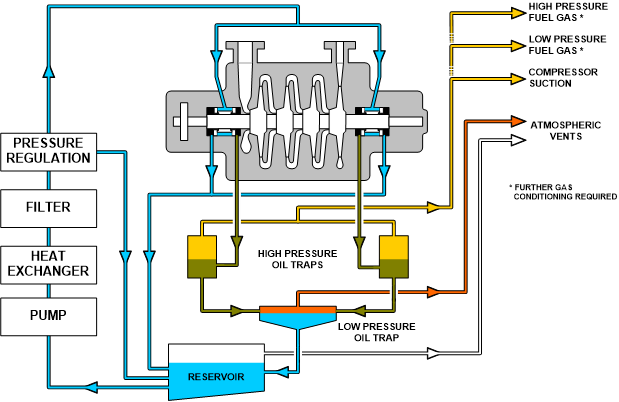
Scenario 4
Non-contacting dry gas seal and the associated seal support system venting to atmosphere.
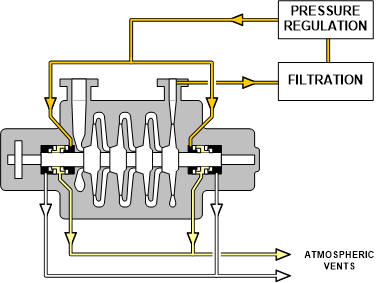
Scenario 5
Non-contacting dry gas seal with a seal gas recovery system scavenging atmospheric emissions and returning them to the compressor.
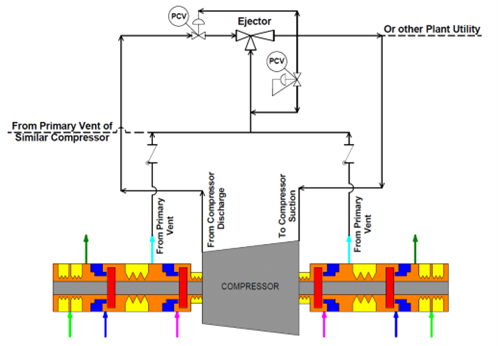
Calculating the results
Upon completion of all the input information, click the “Submit” button. The results will then be displayed.
The calculated results are provided for each of the 5 different sealing technologies and information is grouped as follows:
Annual Operating Costs of the compressor shaft sealing system
The annual operating costs include both spare parts and direct labor to operate the shaft sealing system together with the cost of parasitic losses such as the value of the gas leaked, the cost of the energy that was consumed to compress the gas that has leaked, etc…
One-time Costs
This is a summary of the costs required to implement (retrofit)each of the shaft sealing solutions. Payback is calculated from the total retrofit cost versus the reduction in annual operating costs from a traditional oil seal and the associated seal support system with seal leakage vented to tmosphere.
Present Value Calculations
A summary is provided of the retrofit costs together with the annual operating costs discounted to present value over the period of time the compressor is expected to remain in service.
Power Consumption Calculations
Energy can be a large component of the lifecycle cost of any shaft sealing system. The energy calculated not only includes the direct power requirements to overcome the friction of the shaft seal, but also looks into the energy requirements needed to operate each particular sealing scenario. t does not include the energy requirements to operate the compressor driver.
Carbon Footprint
The summary and total carbon dioxide equivalent emissions include the emissions resulting directly from release of methane to the atmosphere (using the Global Warming Potential inputted by the user in the Carbon Footprint page) together with the emissions resulting from the energy expended o operate the shaft seal and support system including any parasitic losses for each of the shaft sealing solutions.
Total Estimated Lifecycle Cost
The total estimated lifecycle cost is the sum of the costs associated with implementing the shaft sealing solutions and the annual operating costs discounted to present value over the period of time the compressor is expected to remain in service.
Graphs
Graphs are provided indicating the relative total lifecycle cost of each sealing technology over varying time spans and the accumulative carbon dioxide equivalent emissions over time.
Retrofit and Operating Cost Definitions
CfsOperating Cost of Lost Energy from Seal Friction
These are the costs associated with the energy required by the compressor driver to overcome frictional losses of the mechanical seal and any viscous drag caused by the seal oil.
CssOperating Cost of Energy Required to Operate Seal Oil System
These are the costs associated with electrical motors used to circulate the seal oil and forced convection heat exchangers.
ClOperating Cost of Lost Energy and Product Loss due to Leakage
This is the cost associated with the energy used to compress gas that subsequently leaks out of the compressor casing via the mechanical seal together with the value of the leaked gas
CfpOperating Cost of Lost Energy to Overcome Pipe Friction Due To Oil Contamination
This is the cost of the energy consumed by the compressor driver to overcome frictional losses in the compressor discharge pipeline as a result of contamination of the pipe surface from oil leaked by the mechanical seal into the compressor
CenOperating Cost to Replace Consumed Seal Oil
This is the cost of replacing seal oil that is leaked by the mechanical seal either into the compressor or to atmosphere.
CmMaintenance and Downtime Costs
This is a combination of the cost for parts and labor used to maintain the seal and sealing system on scheduled maintenance events and unscheduled seal or system failures together with any costs associated with lost productivity due to the compressor being inoperable.
CpCost of Process and Purge Gas Used During Compressor Blowdown
This is the cost to of the compressed gas lost together with inert blanket gas used to in order to decompress the compressor and facilitate maintenance on the shaft seals.
CgCost of Gas Seal Separation Gas Consumption
This is the cost of the separation gas used with a gas seal that is injected into the separation seal that is fitted in between the gas seal and the compressor bearings.
CicInitial Purchase Cost
This is the initial cost to purchase the sealing solution, and may include engineering, bid process expenses, PO administration, testing, source inspection, and initial spares as appropriate, provided all scenarios are treated in a similar fashion.
CinInstallation Cost
These costs may include special area preparations, installation and connection of utilities piping systems, electrical wiring and instrumentation, installation of auxiliary systems, and special services required at start-up.
CdDecommissioning and Disposal Cost
This is the cost to dispose the existing seal and/or sealing system that is being replaced by the seal upgrade retrofit. The costs are incurred at the time of the retrofit.
Assumptions
Carbon Dioxide Equivalent Emission
| Natural Gas | 0.1809 kg/kWh | CO2e for combustion of natural gas | Source: https://www.epa.gov/energy/greenhouse-gases-equivalencies-calculator-calculations-and-references |
| Diesel | 1.1068 kg/kWh | CO2e for combustion of Distillate fuel oil No. 2 (Diesel) | Source: https://www.eia.gov/tools/faqs/faq.php?id=74&t=11 |
| Gasoline | 0.9537 kg/kWh | CO2e for combustion of gasoline/petrol | Source: https://www.eia.gov/environment/emissions/co2_vol_mass.php |
| Electricity | 0.6159 kg/kWh | CO2e per kWh of electricity |
Source: www.epa.gov/egrid/ eGRID2021
USA Average for the year 2021 = 1357.77 lb/MWh (0.6159 kg/ kWh) USA minimum for the year 2021 = 233.08 lb/MWh (0.1057 kg/ kWh) USA maximum for the year 2021 = 1633.10 lb/MWh (0.7408 kg/ kWh) |
| Methane | 34.0 | kg CO2e per kg of methane |
34.0 GWP - Source: 100 year Global Warming Potential with inclusion of climate-carbon feedbacks, 2013 IPCC AR5, Table 8.7, www.climatechange2013.org/images/uploads/WGIAR5_WGI-12Doc2b_FinalDraft_All.pdf
25.0 GWP - Source: 100 year Global Warming Potential, 2007 IPCC AR4, Table 2.14, www.ipcc.ch/pdf/assessment-report/ar4/wg1/ar4-wg1-chapter2.pdf |
Driver Efficiency
| Driver | Efficiency | Fuel Source |
| Gas Turbine | 55% | Natural Gas |
| Internal Combustion Engine | 45% | Natural Gas |
| Internal Combustion Engine | 45% | Diesel |
| Internal Combustion Engine | 30% | Gasoline |
| Electric Motor | 92% | Electricity |
Fuel Net Calorific Value
| Natural Gas | 950 BTU/ft3 | 35.14 MJ/nm3 | Source: www.unitrove.com/engineering/tools/gas/natural-gas-calorific-value |
| Diesel | 18650 BTU/lb | 43.4 MJ/kg | Source: www.engineeringtoolbox.com/fuels-higher-calorific-values-d_169.html |
| Gasoline | 19100 BTU/lb | 44.4 MJ/kg | Source: www.engineeringtoolbox.com/fuels-higher-calorific-values-d_169.html |
Miscellaneous Conversion Factors
| CO2 Emission Coefficient for Flared Natural Gas | 1.2831E-01 lb/ft3 | 2.0553E-03 kg/L | Source: www.eia.gov/environment/emissions/co2_vol_mass.cfm |
| Flare Efficiency (% of Methane converted to CO2) | 98.0% | Source: https://www3.epa.gov/ttncatc1/dir1/fflare.pdf and https://acp.copernicus.org/articles/23/1491/2023/acp-23-1491-2023.pdf | |